
Green turtles, Chelonia mydas
The "green" in green turtle refers to the coloration of its body fat. It is listed as endangered in Florida. The species has been harvested for centuries for food, but now is threatened with extinction. Green turtles usually grow to 40 inches and weigh from 300 to 350 pounds; 850 pounds have been reported. Compared to other sea turtles, the head is small relative to body size. The upper shell of adults ranges from light to dark olive-brown, sometimes with darker radiating streaks on each shield of the carapace. The plastron below is yellowish. The carapace is black to gray on very young green turtles, and the plastron dusky white. The shell is oval in outline. There are four pairs of costal shields on each side of the central row of plates on the carapace. The paddle-like limbs have a single claw
They nest mainly from July through September in the West Indies, Mexico, South and Central America, and on the east coast of Florida.
Green turtles nest on Ascension Island in the south central Atlantic Ocean from January through April. They then head westward to Brazilian waters, traveling more than 1500 miles to favored feeding grounds
Green sea turtles are perhaps the most famous travelers, migrating great distances. A yearling green turtle tagged and released at Bahia Honda in the Florida Keys in October 1967 was retaken off Cape Hatteras, North Carolina 13 months later, having traveled more than 800 miles. Other Florida-tagged green turtles have been found in Brazilian waters. Green turtles are reported to be strong swimmers, capable of speeds of 0.88 to 1.4 miles per hour. As noted previously, one population of greens is known to nest on Ascension Island and return to the coastal waters of Brazil as their major feeding grounds.
Adult green turtles feed on sea grasses and algae, though very young greens are more carnivorous feeders. One of Florida's seagrasses, Thalassia testudinum, has the common name of "turtle grass" because green turtles graze in the submerged meadows.
Green sea turtles are perhaps the most famous travelers, migrating great distances. A yearling green turtle tagged and released at Bahia Honda in the Florida Keys in October 1967 was retaken off Cape Hatteras, North Carolina 13 months later, having traveled more than 800 miles. Other Florida-tagged green turtles have been found in Brazilian waters. Green turtles are reported to be strong swimmers, capable of speeds of 0.88 to 1.4 miles per hour. As noted previously, one population of greens is known to nest on Ascension Island and return to the coastal waters of Brazil as their major feeding grounds . Green turtles are the only sea turtles that eat plants. They graze on the vast beds of seagrasses found throughout the tropics. Some populations travel over a thousand miles over open ocean to nest on islands in the mid-Atlantic.
The species has been harvested for centuries for their meat and the gelatinous "calipee" that is made into soup. Hunting and egg gathering have reduced their numbers greatly, but now is threatened with extinction.
Most green turtles nest in the Caribbean but 500 to 2000 nests are recorded in Florida each year.
Green turtles usually grow to 40 inches and weigh from 300 to 350 pounds; 850 pounds have been reported. Compared to other sea turtles, the head is small relative to body size. The upper shell of adults ranges from light to dark olive-brown, sometimes with darker radiating streaks on each shield of the carapace. The plastron below is yellowish. The carapace is black to gray on very young green turtles, and the plastron dusky white. The shell is oval in outline. There are four pairs of costal shields on each side of the central row of plates on the carapace. The paddle-like limbs have a single claw.
Green turtles are an endangered species around the world, but they still nest in significant numbers on the east coast of Florida. They are easily distinguished from other sea turtles because they have a single pair of scales in front of their eyes rather than two pairs as the other sea turtles have. The green turtle is the largest of the Cheloniidae family. Female green turtles that nest in Florida average more than three feet in carapace length, and average about 300 pounds in weight. The largest green turtle ever found was 5 feet in length and 871 pounds. Green turtles nest at intervals of 2, 3, or more years. They lay an average of 3 to 5 egg clutches, with about 12 days between each nesting. There are an average of 115 eggs per clutch and they incubate for about 60 days. Nesting season runs from June through October in the U.S. The largest nesting site in the Western Hemisphere is at Tortuguero, Costa Rica.
Description
The green turtle (Chelonia mydas) is named for the greenish color of its body fat. Hatchlings are dark but adults have a smooth, olive-brown shell marked with darker streaks and spots. The bottom shell is white or yellowish and each paddle-shaped flipper usually has one claw. Green turtles can be distinguished from most other sea turtles by the single pair of scales on the front of the head.
The green turtle is found in parts of the Atlantic, Pacific and Indian oceans, primarily in the tropics. The most important nesting grounds for green turtles in the Americas are Tortuguero, on the Atlantic coast of Costa Rica, a few beaches in Surinam, and Venezuelan-owned Aves Island in the eastern Caribbean.
Roughly 60 to 800 green turtle nests are reported each year on the east coast of Florida, most of them between Volusia and Broward counties. On rare occasion nests are found on the west coast in the Panhandle area. A population of immature green turtles can be found year round in the Mosquito Lagoon portion of the Indian River lagoon system on Florida's east coast, and an increase in the number of smaller turtles suggests that this population may be growing. Mosquito Lagoon may be the northern limit of the winter range for green turtles. Immature green turtles also have been reported from the nearshore waters of Hutchinson Island, Cape Canaveral, Broward County, in Florida Bay and in the Cedar Key-Crystal River area.
Green turtles were once abundant in the waters of south Florida and the Caribbean. In 1503, on his fourth and last voyage to the New World, Christopher Columbus reported that his ship came ". . . in sight of two very small and low islands, full of tortoises, as was all the sea about, insomuch that they looked like little rocks, for which reason those islands were called Tortugas." These islands, later renamed the Cayman Islands, were once the site of a large green turtle rookery.
For 300 years the vast flotillas of turtles played an important part in the exploration and exploitation of the region by Europeans, including pirates. Much of the early activity in the new world tropics was dependent in some way on turtles. Turtle meat and eggs provided a seemingly unending supply of protein, and turtles could be kept alive on ships for long voyages by turning them on their backs in a shaded area of the deck. Turtle oil was used for cooking, lamp fuel and as a lubricant.
Besides feeding the explorers and residents of the Caribbean, the green turtle was shipped to Europe, particularly England, where it was considered a great delicacy for its meat and the gelatinous "calipee," found along the lower shell that was made into soup. With the advent of steam travel, more turtles could be shipped alive. By 1878, 15,000 turtles a year were being shipped to England from the Caribbean.
The supply of turtles must have seemed endless as each year new individuals completed the long maturation process and emerged from the sea to nest, but by the early 1700s green turtles were becoming scarce in many areas. The first rookery to be decimated was that of Bermuda and then, one by one, the turtles disappeared from their nesting beaches throughout the region. The green turtles of Florida are a remnant of a much larger population that was hunted to the edge of extinction. Both nesting females and subadult turtles were hunted commercially. In the late 1890's, turtle hunting grounds extended from Marquesas Key to Alligator Light on the east coast, the Dry Tortugas, through Florida Bay and around the Cedar Key region. By the 1940's and 50's, Florida's green turtle population had been greatly reduced but Key West and other ports remained as processing centers for green turtles caught throughout the Caribbean. Although Florida's seagrass beds were once important feeding grounds, it is likely that green turtles nested in large numbers only in the Keys and the Cape Sable region.
Green turtles are found on broad expanses of shallow, sandy flats covered with seagrasses or in areas where seaweeds can be found. Scattered rocks, bars and coral heads are used as nighttime sleeping sites. Every morning the turtles head out to feed and every evening return to their particular shelter to sleep. The round trip may be several miles.
Hatchling green turtles are carnivorous; juveniles and subadults eat many things including man-o-war and jellyfish. When green turtles reach 20 to 25 centimeters (8 to 10 inches) in shell length, however, they begin feeding on algae or seagrasses on shallow flats. No one knows how old the turtles are when this occurs. Adult green turtles are unique among sea turtles in being plant eaters.
The vast beds of seagrasses found throughout the tropics serve as pastures for green turtles. Seagrass is high in fiber and low in protein. As an adaptation to this diet, green turtles maintain "grazing plots" of young leaves by feeding repeatedly in the same area. By eating young plants in the grazing plots, green turtles can avoid older leaves that are higher in fiber, and thus increase the percentage of protein in their diet.
Only adult sea turtle with diet of seagrass and seaweed. Named for greenish color of body fat. 60 to 800 nests reported each year. Medium to large sea turtle: nesting females in Florida average 3.3 feet in length and 300 pounds in weight. Hatchlings: 2 inches long. Nest in Florida from June through late September. Survival in Florida threatened by beach lighting, habitat alterations and drowning in fishing gear.
Some populations of green turtles feed on algae even if seagrass is available. Seagrasses and algae differ in their chemical composition so green turtles have specialized bacteria in their gut to aid digestion. For this reason, green turtles cannot easily change their diet when other food sources become more abundant. The young green turtles found year-round in Mosquito Lagoon eat seagrass even when algae is more abundant.
Since their diet is low in protein, green turtles grow slowly and sexual maturity is delayed. In captivity on a high-protein diet, green turfles can mate and lay eggs in 8 to 11 years. This diet also results in more nests per season and a shorter interval between nesting seasons as compared with wild turtles. It has been estimated that green turtles in the wild may not reach maturity until 15 or even 30 to 50 years of age. Dramatic variations in growth rates have been observed from one feeding area to another, and the differences have been attributed to food quality and temperature. Green turtles have a constant and plentiful source of food with few competitors, but the trade-off is that their growth rate and reproductive output are lower than if their diet were more nutritious.
One of the most intriguing aspects of green turtles is their ability to travel long distances and locate specific sites with remarkable precision. Caribbean turtle fishermen have many stories about capturing a distinctive green turtle, shipping it hundreds of miles to market in Key West where the turtle was washed out of its holding pen in a storm, and then recapturing the same turtle under the same rock as before. Green turtles are as loyal to nesting sites as they are to preferred feeding grounds or sleeping rocks. Some populations of green turtles may nest and graze in the same region and others follow coastlines from feeding to nesting grounds and back. Other populations, however, travel great distances over open water. At some Brazilian feeding grounds, several populations share the same pastures but always return to their respective nesting beaches.
One of the best-studied migratory populations feeds along the Brazilian coast but nests on Ascension Island, which is 8 kilometers (5 miles) wide and 2,250 kilometers (1,400 miles) to the east of Brazil over open ocean. We can only speculate as to why turtles would make such a difficult journey or how they can find this island in the vastness of the mid-Atlantic.
LEARN ABOUT THE DIFFERENT TYPES OF SEA TURTLES....
| LOGGERHEAD | HAWKSBILL | GREEN | LEATHERBACK | OLIVE RIDLEY |
|---|---|---|---|---|
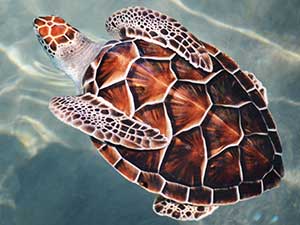 |
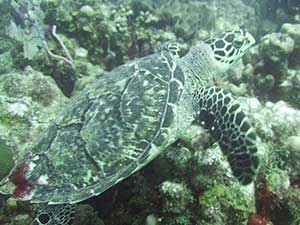 |
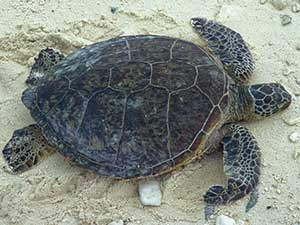 |
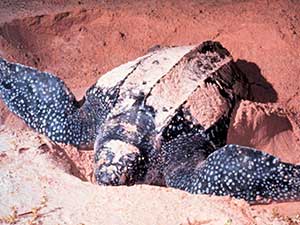 |
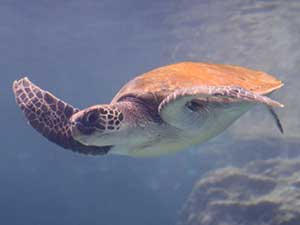 |
